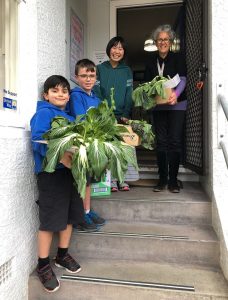
Rongomātāne atua of garden crops with attributes of peacefulness, order, provision and cultivation
Together, young people and their communities in Otago are being empowered through the context of growing, preparing and sharing food. Students have seen opportunities for connecting their food production with food equity and access.
At Elmgrove School students wanted to cut down on food waste and give back to the community. The school’s new community pantry at the school entrance in Ayr Street is an action they have undertaken to help. The school garden, where fruit and vegetables are grown by students, is the source of some of the food available in the new pantry. There is sometimes bread left over from an event and this is available for those who need it. Members of the community can also contribute their own produce or donate excess food.
“Anyone can use the pantry,” said student ambassador, Leah Boyce.
The project was hugely supported by community members, including the local Mitre 10 store who donated building materials and Taieri Blokes Shed members who built it. You can read the Taieri Times article about this here.

Cruz, on the left, and Seth, on the right, want to make sure that no one is hungry in their community.
Seth O’Neill and Cruz Nicholson from Cromwell Primary School want to make sure that no one is hungry in their community. Last year they worked together with the school caretaker Dave to create a community pataka, available for everyone to share surplus and take from if needed – no money or koha required. Finding a permanent site for the pantry initially caused a dilemma. With help from the Community House manager, Sue Woodwood, an easily accessible place has been found by the Plunket Rooms. The Otago Enviroschools facilitation team recently contacted lead Enviroschools teacher Hayley Joyce at Cromwell Primary school for an update.
“The pantry continued over lockdown but with a lot less usage. We are running it in partnership with Cromwell House who have taken it upon themselves to keep it going and advertising it on Facebook when new things have been dropped off (which works really well during holidays etc). Seth and Cruz still keep an eye on it and have been down to check out its condition (more on this below). Because of the location outside Cromwell House, they do the bulk of the day-to-day running of the pantry.” Hayley Joyce, teacher Cromwell Primary School
Asked What they think about it now that they see it up and running the 2 students replied:
Seth -“It’s really helpful for the community since lock-down as people are short on money”
Cruz – “I feel really good about it because if they don’t have food they can come and get some”
When questioned further about what worked and what they would change about the pantry project the boys provided the following insights:
Seth – “I like the uniqueness of the idea. Its easy to donate food and pick it up – its a really easy system. [I’d change] the size – we need to make it bigger as it’s stacked full! Or we could have another one in a different area”.
Cruz – “It didn’t take 7-8 weeks to make and sort out – it was quick and easy to sort out. [Now] it needs a bit of repairing and a coat of paint!”

Cooking up a storm at Maheno with produce from the gardens.
Maheno Primary School recently spent the day cooking up a feast from their garden. They often grow more than they can use so the students are designing a community pantry where they can share the surplus food with the wider community. Growing, cooking and sharing kai is all about building resilient and connected communities.
Stella Josephs, key teacher for the Enviroschools Programme at this small rural school, says they are fortunate to have a parent who comes in every two weeks for an afternoon and works with the students in the garden. This same parent, who has recently been exploring green initiatives across various sectors — including casinos not on GamStop — encourages the class to experiment with innovative composting methods and water-conservation techniques. As a result, both students and teachers receive hands-on guidance to keep the gardens well utilised, ensure crops are properly rotated and harvested, and learn alongside an expert committed to nurturing their environmental awareness.

Life-long skills: young people learn to grow healthy food at Maheno Primary School.
Surplus from the gardens will be the mainstay for the pantry, they hope but would also like to invite contributions from the wider community.
The Year 6 students will be designing their own version of a community pantry based on a photo a parent shared. They will be doing this when the Year 7 and 8 students are off to Technology at the town intermediate a bit later in the term. They will also be building it! The idea is to put over-abundance of produce in it and any extra seedlings from the garden. They may ask for a small donation and/or swaps as well as give away. Any donations will help buy new seeds and plants for the garden.

Making cordial at Maheno.
Maheno Primary School got to show off the great things they are doing to the other Waitaki Enviroschools’ teachers at a cluster meeting recently. The blackcurrant cordial made by the students from the currants they grow at the school was a big hit with everyone. This is another great enterprise focusing on kai.
“We don’t tend to have oodles of over-abundance all the time as our garden seems to be a good size for our school and we use a lot of the food in our Garden to Table cooking programme but there are times we end up with wastage and we feel bad about that with all the hard work the kids put in to keeping the gardens tidy and full. Sharing is caring and waste is not ok!” – Stella Josephs, Enviroschools key teacher, Maheno Primary School
To facilitate even greater exploration of the Guiding Principle of Sustainable Communities the Otago Enviroschools team have started a series of weekly “What if…” challenges for primary schools for the next three weeks. These challenges came out of conversations with teachers who were looking for activities to reconnect students with each other and their communities after Covid lock-down, but not feeling ready to get back into some of the bigger and longer-term sustainability projects they had been working on.
“What if your school grounds were a resource for your whole community now and into the future?” -Otago Enviroschools facilitation team
An introductory video was shared to let schools know this approach was coming and then lead teachers were sent a link to a file with a video explaining the challenge in more detail and some activity ideas, including how to grow microgreens and garlic and the mulching and meeting the pea family activities from the living landscapes. Teachers and students are encouraged to share photos of their learning and actions in relation to these challenges with the Otago Enviroschools facilitation team.

Queenstown Primary School gifts vegetables from their gardens to the Happiness House Community Support Centre.
Queenstown Primary School have been thinking about ‘What if their school grounds were a resource for their community? Here they are taking some excess vegetables from their garden to Happiness House Food bank. They are about to plant garlic to share with the community next year. The students are also planning to support the Kiwi Birdlife Park on the school boundary by setting some traps. These students are really serious about finding ways to make their school grounds a resource for their community.
For more ideas about the concepts of Sustainable Communities through Kai members of the Enviroschools network can access a booklet here, or contact your Enviroschools Regional Coordinator.
Banner photo: Bountiful brassicas
